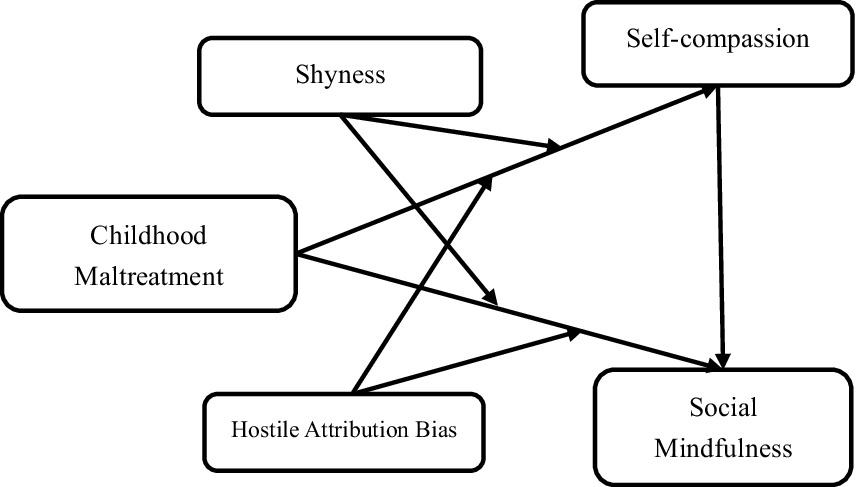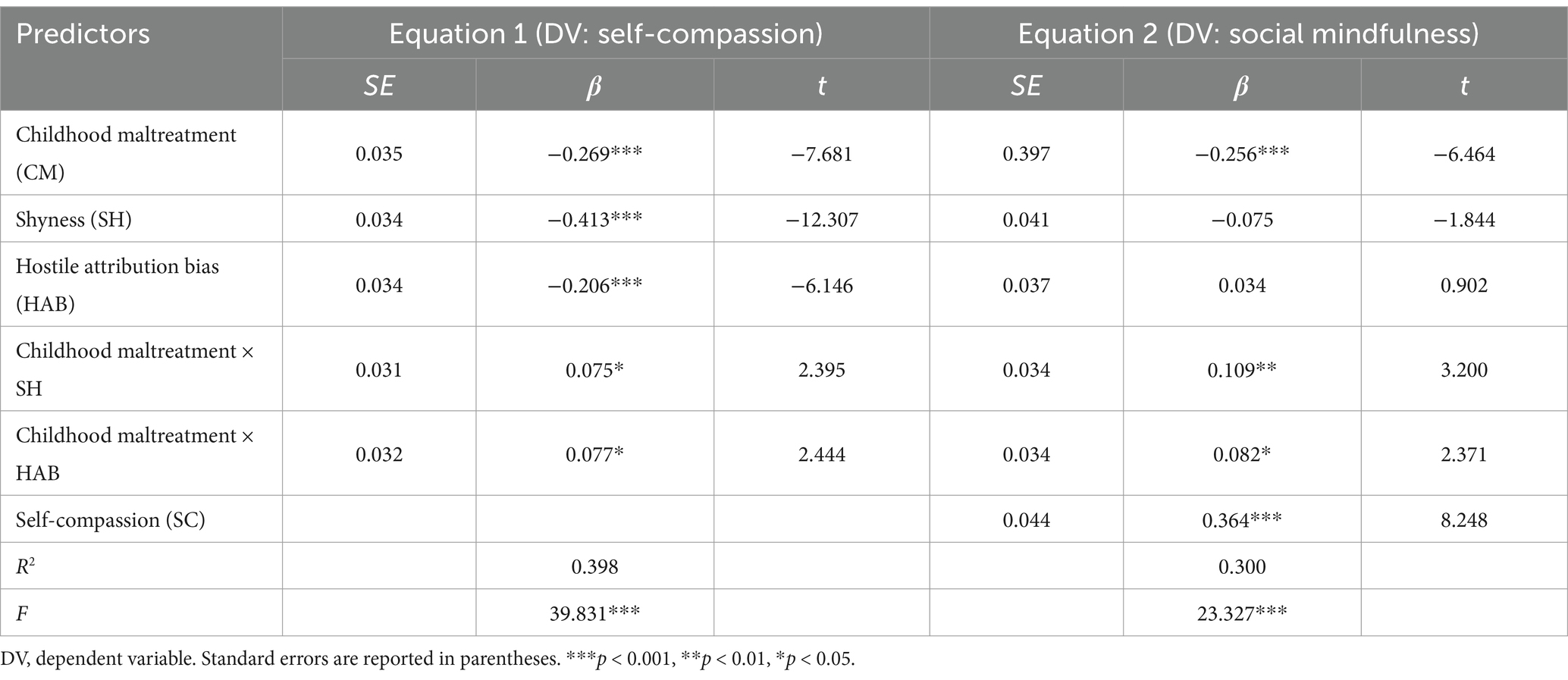- 1College of Education, Ludong University, Yantai, China
- 2Institute for Education and Treatment of Problematic Youth, Ludong University, Yantai, China
- 3Shandong Business Institute, Yantai, China
Background: Childhood maltreatment represents a significant distal risk factor for the social adaptation and development of children and adolescents. However, the impact of childhood maltreatment on individuals’ social mindfulness—an emerging form of “effortless” prosocial behavior—remains largely unexplored.
Objective: To address the gap in understanding the relationship between childhood maltreatment and social mindfulness, To address the gap in understanding the relationship between childhood maltreatment and social mindfulness, we conducted a cross-sectional study to clarify their association and explore potential influencing factors.
Methods: In this study, 611 undergraduates were surveyed to complete a series of questionnaires including Childhood Maltreatment questionnaire-28 item Short Form(CTQ-SF), 17-item Social Mindfulness Self-report Scale(SMSRS), Shyness Scale, Chinese Version of Word Sentence Association Paradigm for Hostility Scale(CV-WSAP-Hostility), Chinese Version of Self-Compassion Scale(CV-SCS). And a moderated mediation model was constructed based on the data results.
Results: Childhood maltreatment negatively predicts social mindfulness and exerts its influence through self-compassion as a mediator. Additionally, shyness and hostile attribution bias (HAB) were found to have significant independent and interactive moderating effects. Specifically, the negative impact of childhood maltreatment on self-compassion and social mindfulness diminished as levels of both shyness and HAB increased.
Conclusion: This study demonstrates that the design of intervention programs for individuals with childhood maltreatment should fully consider the “dual-edged sword” effects of their shy personality traits and HAB and the potential for iatrogenic effects.
Introduction
Social mindfulness refers to an interpersonal form of benevolence characterized by consideration and awareness of others’ needs in decision-making, with minimal or no cost to oneself (Van Doesum et al., 2013, 2021). It represents a low-cost prosocial behavior that prioritizes interpersonal kindness over material gains (Van Doesum et al., 2021). This mindset plays a key role in fostering interpersonal harmony and societal cohesion. At the micro level, it enhances interpersonal favorability and cooperation by recognizing and valuing others’ needs, while at the macro level, it supports the creation of democratic, respectful, and trust-based communities. Given its significant social implications, while existing research has primarily focused on exploring the mechanisms of social mindfulness in general populations, it is imperative for future investigations to extend their attention to vulnerable groups who may exhibit deficiencies in social mindfulness capacities. Given its broad social significance, most research has focused on social mindfulness within general populations, yet further investigation is needed on vulnerable groups that may lack these capacities. Research has shown that childhood maltreatment has lasting negative effects, extending from early childhood into adulthood, often leading to developmental challenges and maladaptive outcomes (Flynn et al., 2014; Greene et al., 2020). The college period represents a critical developmental stage characterized by significant challenges and risks, primarily stemming from students’ transition from family dependence to broader social engagement. The investigation of mechanisms underlying college students’ social mindfulness holds critical significance when examined through both individual developmental and societal functioning lenses.
Childhood maltreatment and social mindfulness
Childhood maltreatment encompasses emotional abuse, physical abuse, neglect, and sexual abuse occurring before age 18 (Johnson et al., 1999). Empirical evidence demonstrates that such early adversity exerts profound and enduring effects on individuals’ self-concept development, emotional regulation, and behavioral patterns (Mell et al., 2021). Specifically, maltreatment impairs cognitive functioning, disrupts interpersonal relationships, and reduces prosocial behaviors, such as altruism and social trust. Conversely, social mindfulness—conceptualized as an altruistic signaling mechanism in interpersonal contexts (Dou et al., 2018; Van Doesum et al., 2013)—has been found to facilitate trust-building and cooperative social dynamics. A critical question is whether the effects of childhood maltreatment on social mindfulness mirror those observed in altruistic behaviors. While current research has yet to empirically support this link, emerging findings challenge the simplistic view that childhood adversity universally undermines prosocial capacities.
Three key considerations warrant attention: First, post-maltreatment growth, as outlined in the Altruism Born of Suffering (ABS) framework (Vollhardt, 2009), suggests that significant adversity can paradoxically promote prosocial development through enhanced socio-cognitive processes like empathy and perspective-taking (Vollhardt and Staub, 2011). Second, social mindfulness differs from traditional prosocial behavior in that it is a low-cost practice, requiring minimal behavioral investment as individuals become attuned to others’ needs (Yan et al., 2022). While traditional prosocial behaviors often involve substantial psychological costs (Song et al., 2018), social mindfulness remains independent of resource-sharing paradigms, making it a more feasible and scalable approach (Zhao et al., 2022). This unique blend of prosocial essence with behavioral feasibility positions social mindfulness as a promising intervention target. These insights suggest that maltreatment-informed social mindfulness interventions, grounded in developmental psychopathology, may offer greater ecological validity and implementation efficacy compared to traditional prosocial training, ultimately contributing to enhanced societal trust and community resilience.
The mediation role of self-compassion
Serving as an adaptive emotion regulation mechanism, self-compassion buffers against the negative effects of adverse experiences (Peter and Gazelle, 2017). Unlike trait-like characteristics, self-compassion is malleable, with empirical evidence supporting its enhancement through targeted interventions and skill development (Neff, 2023; Bian, 2019; Hofmann et al., 2011). In the context of maltreatment recovery, self-compassion helps individuals (a) cognitively reframe painful experiences, (b) develop awareness of universal suffering, and (c) build meaningful connections based on shared humanity. This process fosters heightened empathy in maltreatment-exposed individuals, which in turn enhances altruistic behaviors and supports the development of social mindfulness through increased awareness of communal needs. Research further indicates that higher empathy in maltreated populations is associated with psychological resilience (Luo et al., 2021) and prosocial behaviors such as social support, trust-building, and emergency intervention (Welp and Brown, 2014). Given the well-documented therapeutic benefits of self-compassion for survivors of childhood maltreatment and its role as a relational catalyst, the current study examines its mediating role in the pathway from childhood maltreatment to social mindfulness, highlighting potential applications for maltreatment-informed social mindfulness enhancement programs.
The moderation role of shyness and hostile attribution bias
Shyness, defined as a pervasive pattern of social inhibition and hypersensitivity to interpersonal evaluation (Henderson and Zimbardo, 2001), results from complex interactions between internalized psychological distress and impaired social functioning. According to the metacognitive model and the social fitness framework, shyness is characterized by maladaptive self-appraisals, excessive self-monitoring, and significant difficulties in social adjustment and prosocial behavior (Li and Li, 2023). Research indicates that the development of shyness is linked to poor parent–child relationships during early childhood (Doyle and Cicchetti, 2017), with childhood maltreatment exacerbating the emergence of extreme shyness, marked by heightened rumination and reactive aggression. Empirical studies also show a strong negative correlation between shyness and conventional prosocial behaviors (Li et al., 2018). However, paradoxically, heightened shyness correlates with increased online helping behaviors under conditions of reduced social evaluation pressure (Han et al., 2016). This apparent paradox suggests that shy individuals’ capacity for mindful prosocial expression may be selectively inhibited by context-dependent social appraisal mechanisms rather than reflecting global prosocial deficits.
Hostile attribution bias (HAB) refers to the tendency to interpret ambiguous situations as hostile or threatening (Huppert et al., 2007). Empirical evidence supports that the formation and development of hostile attribution bias have been found to be significantly associated with early harsh parental disciplinary practices (e.g., physical punishment, verbal criticism) and maladaptive attributional styles (Lee et al., 2020). Individuals exposed to harsh parenting may develop internal working models characterized by hostile perceptions of others, demonstrating a tendency to attribute negative intentions in ambiguous social contexts (Healy et al., 2015). Grounded in the Social Information Processing Model (Crick and Dodge, 1994), when individuals consistently interpret ambiguous social cues as hostile rather than benign, this cognitive pattern becomes a stable personality trait that influences behavioral responses (Dodge, 2006). Empirical evidence further demonstrates that attributional retraining programs, which promote prosocial interpretations, can enhance prosocial biases, leading to reduced anger and aggression, as well as improved well-being (Bockstaele et al., 2019). Therefore, the present study aims to explore the moderating roles of two stable individual difference factors—socio-emotional traits (operationalized as shyness) and cognitive processing tendencies (manifested as hostile attribution bias)—in shaping the relationship between early adverse experiences and subsequent social mindfulness capacities.
The present study
The present study aims to explore the relationship between childhood maltreatment and social mindfulness among college students, mainly focusing on the mechanism of shyness, hostile attribution bias and self-compassion during this process. The proposed hypotheses are as follows: (H1) Childhood maltreatment experiences significantly influence social mindfulness among college students. (H2) Self-compassion mediates the relationship between childhood maltreatment and social mindfulness in college students. (H3) Shyness moderates the associations between childhood maltreatment and both self-compassion and social mindfulness in the proposed mediation model. (H4) Hostile attribution bias moderates the relationships between childhood maltreatment and both self-compassion and social mindfulness within the mediation framework. The hypothesis model is depicted in Figure 1.
Method
Participants
Based on the a priori sample size for structural equation models references (Soper, 2022), we applied G*power software to determine the sample size. Using an expected medium effect size (f2 = 0.15), an alpha level of 0.05, and a desired statistical power of 0.8., the analysis indicated that a total sample size of 85 participants would be required to detect the expected differences with adequate power. A total of 643 adolescents were recruited from a college in Shandong Province, China, using stratified random cluster sampling. Participants who had a response time of less than 4 min or failed to complete all items (n = 32) were excluded from the analysis. The final sample consisted of 611 participants (43.9% female), with ages ranging from 16 to 22 years. The participants’ living areas were as follows: 65.6% from rural areas, 22.3% from towns, and 12.1% from cities. Parental education levels indicated that 95.1% of fathers and 96.7% of mothers had a high school education or lower.
Measures
Childhood maltreatment
Childhood maltreatment was assessed using the Chinese version of the Childhood Maltreatment Questionnaire Short Form (CTQ-SF) (Bernstein et al., 2003). The CTQ-SF consists of 28 items (seven of which are reverse-scored to assess response consistency) and measures experiences of childhood maltreatment across five dimensions: emotional abuse, emotional neglect, physical abuse, physical neglect, and sexual abuse. A sample item is: “Someone in my family said mean or insulting words to me before I was 16 years old.” Participants reflected on their experiences before the age of 16 and responded on a 5-point scale (1 = never, 5 = always). The total childhood maltreatment score is the sum of scores across all subscales, with higher scores indicating more frequent maltreatment. The Cronbach’s alpha for the full scale in the current study was 0.85, and for the five dimensions, it ranged from 0.65 to 0.76.
Social mindfulness
Social Mindfulness Self-report Scale (SMSRS) developed by Tian et al. (2021) was used to measure social mindfulness against the background of Chinese culture. The 17-item SMSRE contains two second-order factors (agreeableness and extraversion) and four first-order factors (kindness and respect, humility, optimism and open-mindedness, tolerance and understanding) for the internalization of social mindfulness. Participants respond on a 5-point score ranging from 1 = not at all true of me to 5 = very true of me (e.g., “I’ll not publicize it after I did something good.”). The sum of the four factors is the total score of social goodness. Cronbach’s alpha for the scale in the current study was 0.90, and Cronbach’s alpha for the four dimensions was 0.67 ~ 0.81.
Shyness
Shyness scale for Chinese junior high school students developed by Chen et al. (2015) was used to measure the level of shyness of the students. This scale consists of five dimensions: self-expression shyness, shyness toward stranger, shyness for negative social evaluation, shyness toward the opposite sex, humility shyness. Participants respond on a 5-point score ranging from 1 = not at all true of me to 5 = very true of me (e.g., “When I am noticed by the opposite sex, I feel blushed and embarrassed.”). Higher values represent that participants had higher level of shyness. Confirmatory factor analysis was performed because of the differences in the age of the participants. CFA model yielded acceptable fit indices (CFI = 0.92, RMSEA = 0.06, IFI = 0.93, NFI = 0.90). It indicates that this questionnaire is also suitable for the college students. Cronbach’s alpha for the scale in the current study was 0.94, and Cronbach’s alpha for the five dimensions was 0.60 ~ 0.89.
Self-compassion
The Chinese Version of Self-Compassion Scale (CV-SCS) revised was used to assess the level of the students’ self-compassion (Chen et al., 2011). This questionnaire comprises 26-item with six dimensions, namely self-kindness, self-judgment, common humanity, isolation, mindfulness and over-identification. Responses are given on a 5-point scale from (1 = almost never, 5 = almost always). Items representing uncompassionate responses to suffering are reverse-coded. Then means are calculated for each subscale, and grand mean is calculated that represents an overall measure of self-compassion. Higher values represent that participants had higher level of self-compassion. Cronbach’s alpha for the scale in the current study was 0.87, and Cronbach’s alpha for the six dimensions was 0.65 ~ 0.80.
Hostile attribution bias
The Chinese version of Word Sentence Association Paradigm for Hostility Scale (WSAP-Hostility) revised by Quan (2019) will be adopted to measure hostile attribution bias. In current study, a total of 16 items with a 6-point scale from (1 = not relevant at all, 6 = very relevant) are used to evaluate the correlation between hostile words and sentences in ambiguous situations, and the mean of the final score was the score of hostile attribution bias. Cronbach’s alpha for the scale in the current study was 0.93.
Analyses strategy
SPSS 26.0 was used to calculate descriptive statistics and correlations. We then use confirmatory factor analysis (CFA) in AMOS 27.0 to check the factorial validity of the scales. The SPSS macro program compiled by Hayes (2013) was used to test the moderated mediation analysis.
Results
Common methodological deviation test
Harman single factor method was used to test the possible common methodological deviation (Podsakoff et al., 2003). A total of 25 factors were found to have eigenvalues greater than 1, among which the variance explained by the first factor was 17.55%, less than 40%. Therefore, there is no significant common methodological bias in current study.
Variable correlations
This study included a sample of 611 college students. Table 1 shows the standard deviations and correlation coefficients for all study variables. Correlation analyses revealed three significant positive associations: between childhood maltreatment and shyness, childhood maltreatment and hostile attribution bias, and between shyness and hostile attribution bias. Additionally, self-compassion was positively correlated with social mindfulness. Both self-compassion and social mindfulness exhibited significant negative correlations with childhood maltreatment, shyness, and hostile attribution bias.
The moderated mediation effect
The results of correlation analysis meet the statistical requirement for testing mediation effects (Wen and Ye, 2014). The SPSS macro program1 compiled by Hayes (2013) was used to test the moderated mediation analysis with model 10. The regression analysis results (see Table 2 and Figure 2) revealed that childhood maltreatment significantly and negatively predicted social mindfulness (c’ = −0.256, p < 0.001) and self-compassion (a = −0.269, p < 0.001). In contrast, self-compassion significantly and positively predicted social mindfulness (b = 0.364, p < 0.001). The mediation analysis indicated that the indirect effect of self-compassion on the relationship between childhood maltreatment and social mindfulness, ab = −0.098, with a 95% confidence interval of [0.277, 0.185]. The proportion of the relative mediation effect was ab/(ab + c’) = 27.67%.
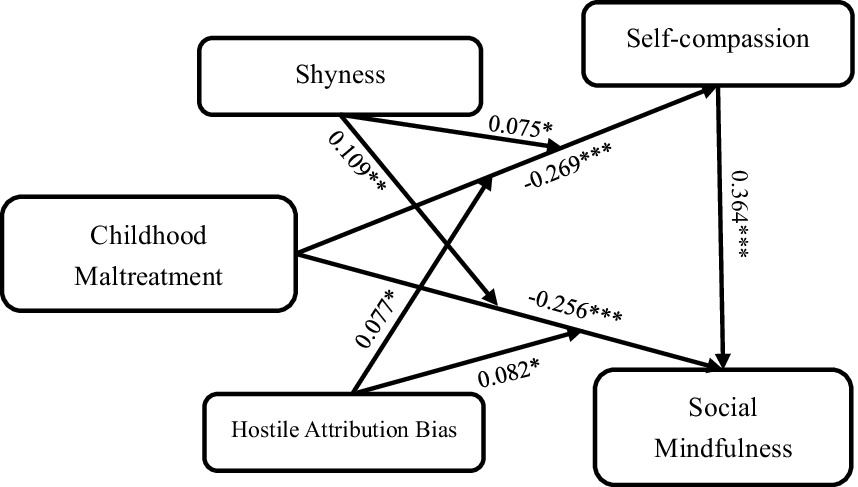
Figure 2. The moderated mediation effect model and parameter standardization estimate. *p < 0.05, **p < 0.01, ***p < 0.001.
Furthermore, shyness and hostile attribution bias were included as moderators in the regression analysis. The results demonstrated that the interaction term between childhood maltreatment and shyness significantly predicted self-compassion (β = 0.075, p < 0.05) and social mindfulness (β = 0.109, p < 0.001). Similarly, the interaction term between childhood maltreatment and hostile attribution bias also significantly predicted self-compassion (β = 0.077, p < 0.05) and social mindfulness (β = 0.082, p < 0.05). The findings demonstrate that shyness and hostile attribution bias, as stable personality traits and cognitive patterns, play a moderating role in the associations linking childhood maltreatment to both social mindfulness and self-compassion.
To further elucidate the moderating effects of shyness and hostile attribution bias, we conducted simple slope analyses by categorizing participants into high (M + 1SD) and low (M – 1SD) groups based on ±1 standard deviation from the mean scores of these two moderators. To visualize interaction patterns, simple effect analyses were conducted (Figures 3–6). The analysis revealed differential patterns based on shyness levels: For individuals with low shyness, childhood maltreatment significantly negatively predicted self-compassion (βsimple = −0.344, t = −6.585, p < 0.001). Conversely, this negative predictive effect was attenuated in highly shy individuals while remaining significant (βsimple = −0.194, t = −4.737, p < 0.001), indicating that increased shyness levels weakened the detrimental impact of childhood maltreatment on self-compassion (Figure 3). Similarly, childhood maltreatment showed significant negative effects on self-compassion under low HAB conditions (βsimple = −0.347, t = −6.884, p < 0.001). Although this negative association persisted at high HAB levels, its magnitude was substantially reduced (βsimple = −0.192, t = −4.367, p < 0.001), demonstrating HAB’s buffering role against the adverse effects of childhood maltreatment (Figure 4). Furthermore, the pattern extended to social mindfulness outcomes. Childhood maltreatment exerted strong negative effects on social mindfulness at low shyness levels (βsimple = −0.365, t = −6.246, p < 0.001). This relationship, while remaining statistically significant, showed progressive attenuation with increasing shyness (βsimple = −0.148, t = −3.276, p < 0.001) (Figure 5). Notably, the moderating role of HAB mirrored the patterns observed with shyness. Higher HAB levels progressively diminished childhood maltreatment’s negative impact on social mindfulness, with significant effects persisting at both low (βsimple = −0.338, t = −5.983, p < 0.001) and high HAB conditions (βsimple = −0.175, t = −3.629, p < 0.001) (Figure 6), a significant synergistic interaction emerged between shyness and HAB (ΔR2 = 0.024, p < 0.001). The combined moderating effect revealed maximum negative impact of childhood maltreatment on social mindfulness when both shyness and HAB were low (βsimple = −0.447, p < 0.001), contrasting with minimal and non-significant effects when both moderators were elevated (βsimple = −0.066, p = 0.162).
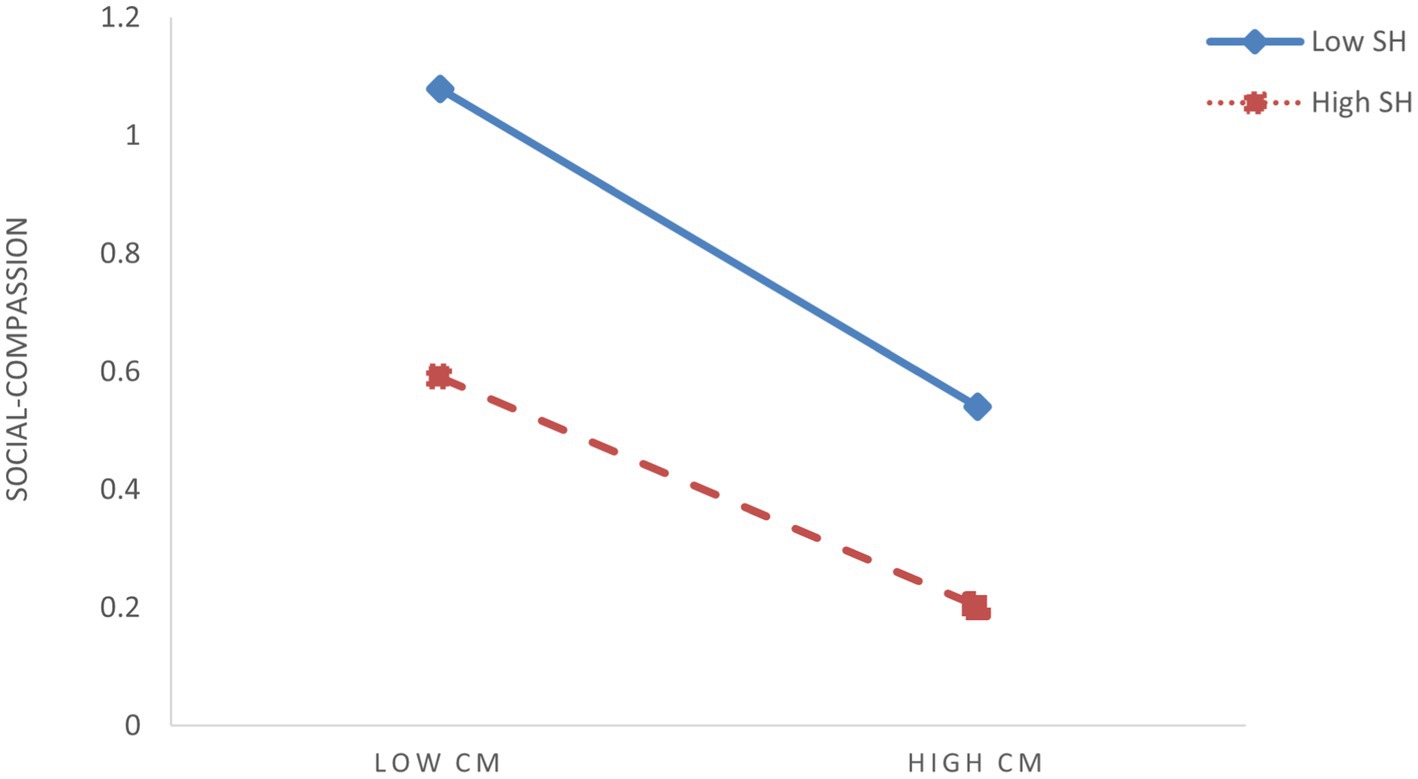
Figure 3. The moderating effect of shyness on the relationship between childhood maltreatment (CM) and social-compassion (SC).
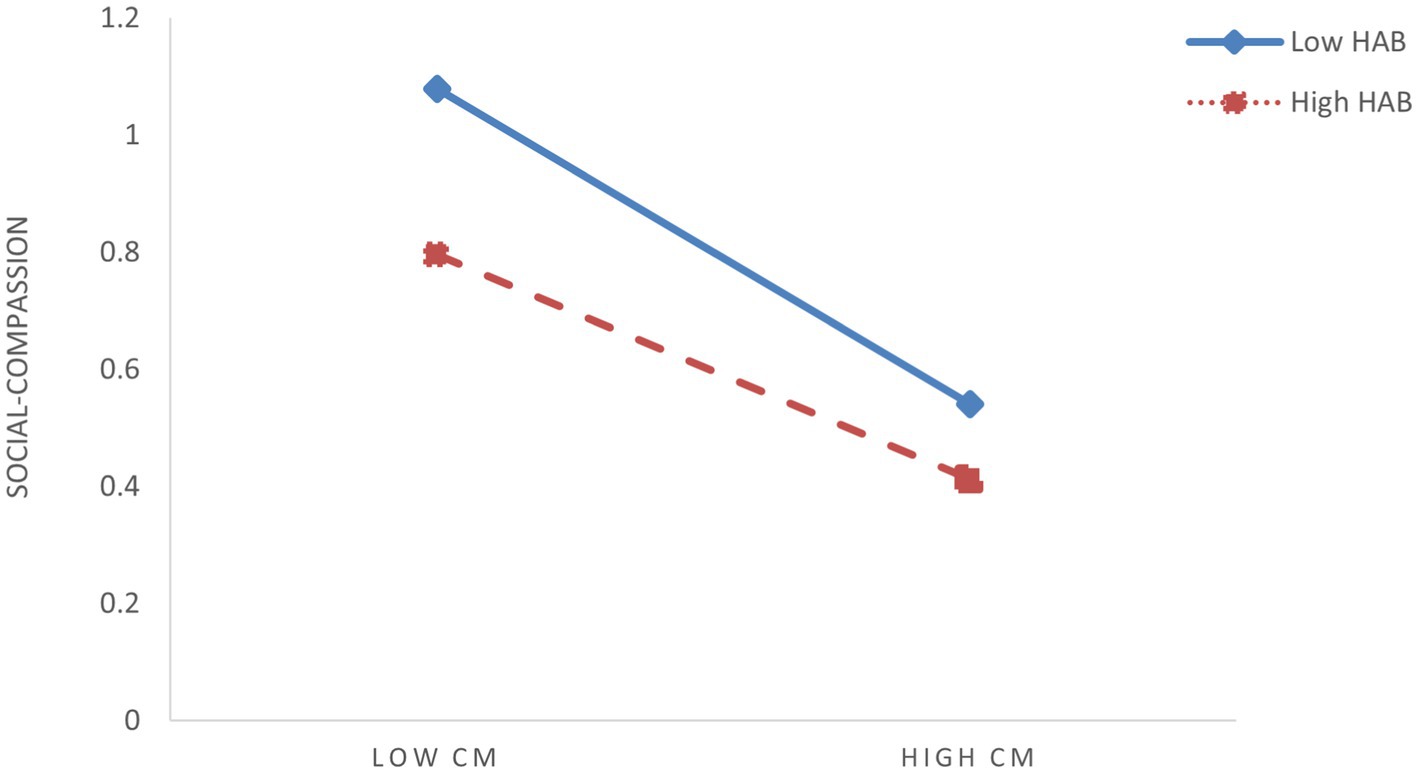
Figure 4. The moderating effect of HAB on the relationship between childhood maltreatment (CM) and social-compassion (SC).
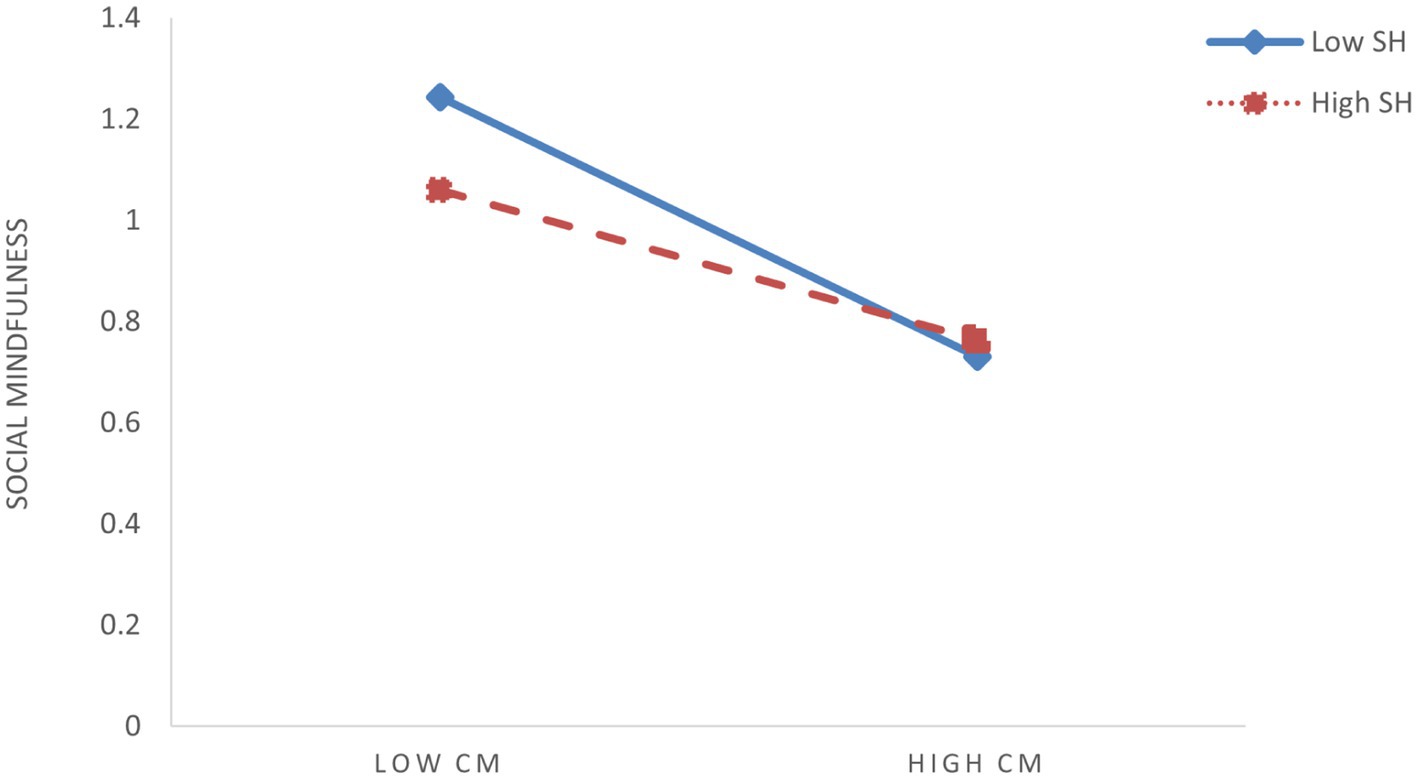
Figure 5. The moderating effect of shyness (SH) on the relationship between childhood maltreatment (CM) and social mindfulness (SM).
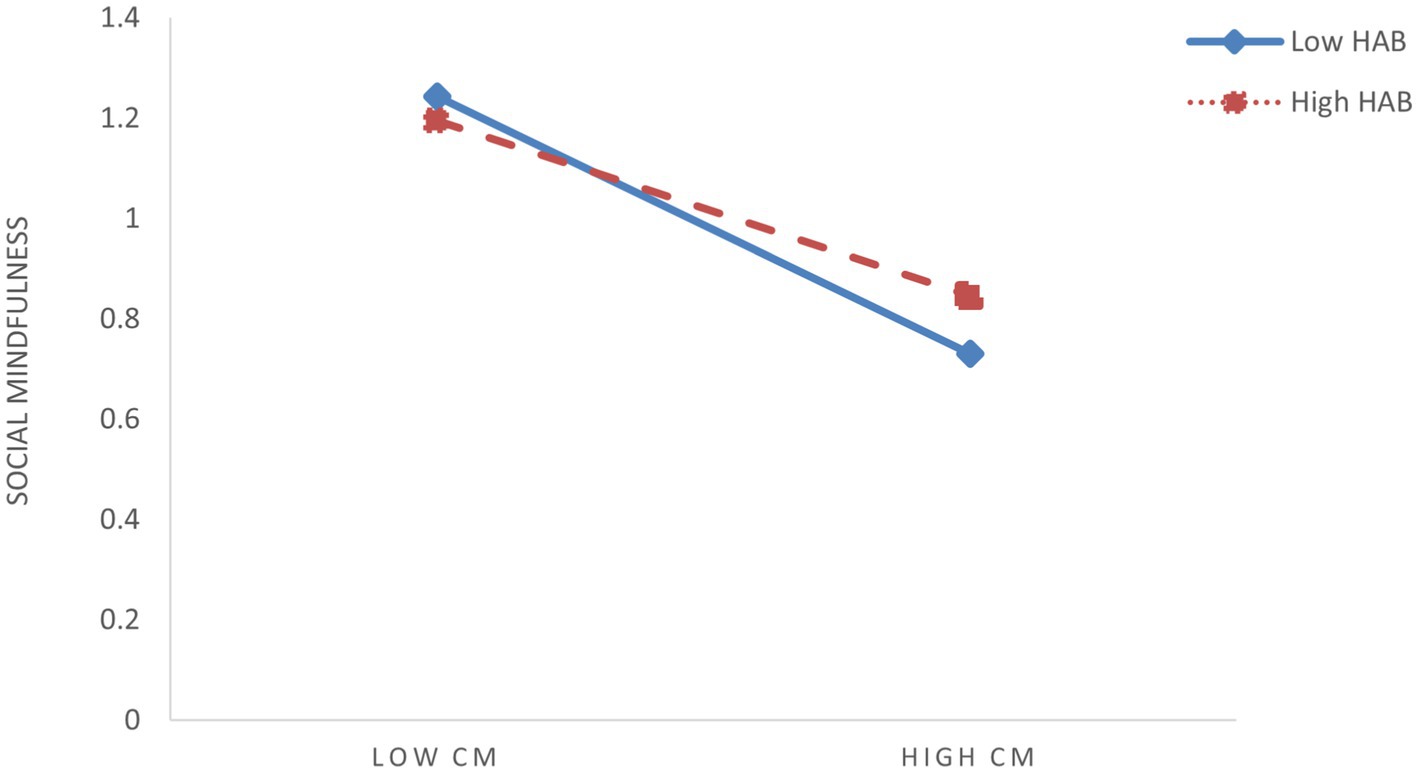
Figure 6. The moderating effect of HAB on the relationship between childhood maltreatment (CM) and social mindfulness (SM).
Discussion
Childhood maltreatment and social mindfulness among college students
The results of this study indicate that childhood maltreatment significantly and negatively predicts social mindfulness. Specifically, individuals exposed to higher levels of childhood maltreatment exhibit lower levels of prosocial orientation, supporting Hypothesis 1. These findings are consistent with prior research on the link between childhood maltreatment and prosocial behavior (Zhuo, 2022; Zhang, 2023; Xu and Yang, 2024) and highlight the lasting detrimental effects of childhood trauma as a distal risk factor for social adaptation and developmental trajectories (Wang et al., 2022; Zheng et al., 2023; Sun et al., 2024; Huang et al., 2024). Victims of childhood maltreatment are particularly vulnerable to a range of adverse psychosocial outcomes throughout both childhood and adulthood (Font and Berger, 2015). Empirical evidence indicates that college students from rural backgrounds report significantly higher levels of childhood emotional maltreatment, a pattern strongly linked to their socioeconomic status and familial cultural contexts (Hou et al., 2017; Huang et al., 2024). In the current study, participants reported higher rates of childhood physical and emotional neglect, which may be linked to their families’ socioeconomic conditions. Specifically, many participants’ parents are migrant workers with limited educational attainment, often preoccupied with securing livelihoods, leading to minimal parent–child interaction and reduced familial engagement. Furthermore, the relationship between childhood maltreatment and social mindfulness in this study mirrors its association with prosocial behavior (Zhang, 2023; Xu and Yang, 2024), suggesting that childhood maltreatment broadly impairs both helping thoughts and behaviors. However, although this study did not directly compare social mindfulness and prosocial behavior within the same research framework, insights from Van Doesum et al.’s (2013, 2021) work suggest that social mindfulness focuses more on subtle, context-specific decision-making, whereas prosocial behavior encompasses a broader range of actions. Social mindfulness may be more susceptible to the indirect effects of childhood trauma, while prosocial behavior could operate through different mechanisms. This limitation presents an opportunity for future research.
The mediation effect of self-compassion
This study demonstrates that self-compassion mediates the relationship between childhood maltreatment and social mindfulness. Specifically, individuals who have experienced childhood maltreatment can mitigate its negative effects on social mindfulness by fostering their self-compassion abilities. This finding supports Hypothesis 2 and aligns with previous research suggesting that self-compassion acts as a protective factor against various emotional disorders (Peter and Gazelle, 2017; Wu et al., 2021). From the perspective of individual motivation, the desire to cultivate self-compassion is linked to pain-related stimuli, as individuals are inherently motivated to alleviate suffering (Gilbert, 2019). Just as childhood maltreatment has numerous proximal and distal adverse effects on individual development, the psychological and physical pain it causes may activate self-compassion, positioning it as a key factor in fostering altruism after suffering. From a socio-psychological standpoint, self-compassion also serves as a motivation for reciprocal exchange (Gilbert, 2019), helping individuals strengthen their connections with others, gain broader perspectives, and develop the capacity to care for others (Neff, 2023). Thus, self-compassion training is essential for individuals who have experienced childhood maltreatment. Such training can help reduce excessive self-criticism, build resilience, and empower individuals to face challenges, ultimately contributing to social harmony and stability.
The moderating effects of shyness and hostile attribution bias
This study examines the impact of childhood maltreatment on self-compassion and social mindfulness, as well as the moderating roles of shyness and hostile attribution bias (HAB) in this relationship. The results show that childhood maltreatment significantly negatively predicts both self-compassion and social mindfulness, with self-compassion serving as a mediator. Additionally, shyness and HAB significantly moderate the effects of childhood maltreatment on self-compassion and social mindfulness, exhibiting a synergistic moderating effect. Hypotheses 3 and 4 were supported.
Moderating role of shyness
The study shows that shyness, as an individual trait, can buffer the negative impact of childhood maltreatment on both self-compassion and social mindfulness, demonstrating a “double-edged sword” effect. In more positive contexts (i.e., low levels of childhood trauma), individuals with lower levels of shyness are more likely to exhibit higher social mindfulness and can enhance it through self-compassion. However, in more negative contexts (i.e., high levels of childhood trauma), high shyness acts as a protective factor, reducing the negative impact of childhood maltreatment on both self-compassion and social mindfulness. The Social Fitness Model of Shyness posits that shy individuals demonstrate self-enhancement bias in social contexts, characterized by overestimation of negative evaluations from others and underestimation of their own social performance, thereby contributing to maladaptive emotional responses, cognitive patterns, and behavioral tendencies (Henderson, 2014). This theoretical framework extends to explain the manifestation of social mindfulness in shy populations. Individuals with lower shyness levels, possessing better social adaptation capabilities, tend to exhibit higher levels of social mindfulness. However, the expression of these behaviors requires a supportive environment. In the context of childhood maltreatment, individuals with lower levels of shyness may become more vulnerable to external pressures, lacking introspection, which negatively impacts their self-compassion and social mindfulness. In contrast, highly shy individuals may internalize their pain, reducing sensitivity to external harm, which mitigates the negative effects of childhood maltreatment on both self-compassion and social mindfulness.
Moderating role of hostile attribution bias
The analysis further reveals that hostile attribution bias (HAB) moderates both the initial stage of the mediation pathway and the direct effect pathway, demonstrating regulatory mechanisms analogous to those observed in shyness. These findings highlight the dual role of HAB in influencing social mindfulness among individuals with a history of childhood maltreatment. Specifically, under benign environmental conditions (i.e., low activation of childhood maltreatment), lower levels of HAB helped mitigate the negative effects of maltreatment on self-compassion and social mindfulness, whereas higher HAB levels hindered these adaptive outcomes. Paradoxically, under adverse conditions (i.e., high activation of childhood maltreatment), individuals with lower HAB exhibited diminished social mindfulness, while those with higher HAB demonstrated a protective resilience, attenuating the negative impacts of childhood trauma on both self-compassion and social mindfulness. This paradox may stem from differing cognitive appraisal patterns. High-HAB individuals tend to “rationalize” traumatic events, such as attributing blame to others, which reduces self-blame and fosters tolerance toward others. Consistent with Social Information Processing (SIP) theory (Dodge, 2006), HAB, as a maladaptive attributional style, may serve defensive functions in threat-laden contexts. However, it is important to note that this buffering effect is not entirely offset. The reason lies in the fact that although HAB may reduce emotional pain in the short term, chronic high HAB can lead to social isolation, interpersonal conflict, or mental health issues (e.g., depression), ultimately undermining its protective function.
Joint moderating effects of shyness and hostile attribution bias
The findings of this study indicate that shyness and hostile attribution bias (HAB) jointly moderate the relationship between childhood maltreatment and self-compassion as well as social mindfulness. When both factors interact, the negative impact of childhood maltreatment on self-compassion and social mindfulness is further attenuated. The cognitive-behavioral model of social anxiety posits that individuals with social anxiety exhibit inherent negative cognitive patterns, characterized by maladaptive beliefs about themselves and their social environments. Empirical evidence supports that interventions targeting negative interpretation biases can significantly improve social adaptation in shy individuals (Tang, 2020), and there may be a shared emotional mechanism between shyness and HAB (Weeks et al., 2016). Fabes and Eisenberg (1992) proposed that higher emotional sensitivity and lower emotional regulation may contribute to the development of shyness, while hostile attribution bias is consistently associated with high emotionality and low emotional regulation (Smeijers et al., 2019). Thus, the synergistic moderating effect observed in this study may stem from the complementary cognitive and affective mechanisms of shyness and HAB. Specifically, shyness may reduce sensitivity to external stimuli, while HAB may alter cognitive appraisals of threatening events, together buffering the negative impacts of childhood maltreatment.
Implications and limitations
This study investigates how childhood maltreatment, as a distal developmental risk factor, influences individuals’ social mindfulness capacities. The results reveal that self-compassion serves as a key mediating mechanism, suggesting that self-compassion training could be an effective intervention to help individuals with adverse childhood experiences manage psychological distress, foster post-traumatic growth, and improve prosocial functioning. Additionally, we systematically investigated the moderating roles of two stable individual difference factors—shyness (a socio-emotional dispositional characteristic) and hostile attribution bias (HAB, a cognitive processing tendency)—in shaping the relationship between early adversity and social mindfulness. The results demonstrated significant independent and interactive moderating effects of shyness and HAB. Specifically, the detrimental impacts of childhood maltreatment on self-compassion and social mindfulness attenuated progressively with increasing levels of both shyness and HAB. However, this buffering effect manifested a dual-edged nature, implying that while these traits may provide temporary psychological protection, they could also limit long-term socioemotional development. These results highlight the importance of considering boundary conditions and potential iatrogenic effects when designing trauma-informed interventions.
Nevertheless, this study has several limitations that require further attention. First, the cross-sectional design prevents causal inferences or the examination of the dynamic relationships between these variables over time. Additionally, the sample primarily consists of college students, which may limit the generalizability of the findings. Future research could explore how social mindfulness varies across individuals with diverse backgrounds, personality traits, and behavioral tendencies. Second, the reliance on self-report measures may introduce social desirability bias. Future studies could incorporate peer evaluations of social mindfulness or experimental designs that manipulate childhood maltreatment levels to improve the validity of the results. Third, while this study focused on social mindfulness, it did not account for prosocial behavior, which could serve as a relevant control variable in future research. Moreover, the selection of control variables, such as personality traits (e.g., extraversion and agreeableness), mental health factors (e.g., depression and anxiety), and cultural considerations, should be more thoroughly addressed in future studies to provide a more comprehensive understanding of these dynamics.
Conclusion
This study draws the following conclusions:
1. Childhood maltreatment experiences have a significant impact on social mindfulness in college students.
2. Self-compassion mediates the relationship between childhood maltreatment and social mindfulness in college students.
3. Shyness and hostile attribution bias moderate the associations between childhood maltreatment, self-compassion, and social mindfulness within the proposed mediation model, with both factors exerting a joint moderating effect on the relationship between childhood maltreatment and both self-compassion and social mindfulness.
Data availability statement
The raw data supporting the conclusions of this article will be made available by the authors, without undue reservation.
Ethics statement
The studies involving humans were approved by Institutional Review Board of Ludong University. The studies were conducted in accordance with the local legislation and institutional requirements. Written informed consent for participation in this study was provided by the participants’ legal guardians/next of kin.
Author contributions
XYW: Conceptualization, Methodology, Formal analysis, Writing – original draft, Writing – review & editing. GLY: Data curation, Investigation, Resources, Writing – review & editing. WJM: Conceptualization, Methodology, Supervision, Validation, Writing – review & editing.
Funding
The author(s) declare that financial support was received for the research and/or publication of this article. This research was supported by the Social Science Foundation of Shandong Province of China (18CJY03); 2023 Shandong Province Social Science Special Project (Project No.: 23CSZJ44); 2023 Shandong Province Education Science Planning Key Project (Project No.: 2023ZD062).
Conflict of interest
The authors declare that the research was conducted in the absence of any commercial or financial relationships that could be construed as a potential conflict of interest.
Publisher’s note
All claims expressed in this article are solely those of the authors and do not necessarily represent those of their affiliated organizations, or those of the publisher, the editors and the reviewers. Any product that may be evaluated in this article, or claim that may be made by its manufacturer, is not guaranteed or endorsed by the publisher.
Footnotes
References
Bernstein, D. P., Stein, J. A., Newcomb, M. D., Walker, E., Pogge, D., Ahluvalia, T., et al. (2003). Development and validation of a brief screening version of the childhood maltreatment questionnaire. Child Abuse Negl. 27, 169–190. doi: 10.1016/S0145-2134(02)00541-0
Bian, X. H. (2019). The influence of self-compassion on negative bias and intervention (doctorial dissertation). Shanghai: East China Normal University.
Bockstaele, B. V., Molen, M. J. V. D., Nieuwenhuijzen, M. V., and Salemink, E. (2019). Modification of hostile attribution bias reduces self-reported reactive aggressive behavior in adolescents. J. Abnorm. Child Psychol. 47, 325–332. doi: 10.1007/s10802-018-0450-6
Chen, J., Yan, L. S., and Zhou, L. H. (2011). Reliability and validity of Chinese version of self-compassion scale. Chin. J. Clin. Psych. 19, 734–736. doi: 10.16128/j.cnki.1005-3611.2011.06.006
Chen, Y. M., Zhang, Y. J., Wu, Y. P., and Gao, F. Q. (2015). Development of shyness scale for Chinese junior high school students. J. Shandong Normal Univ. 30, 75–78. doi: 10.3969/j.issn.1001-4748.2015.01.018
Crick, N. R., and Dodge, K. A. (1994). A review and reformulation of social information-processing mechanisms in children's social adjustment. Psychol. Bull. 115, 74–101. doi: 10.1037/0033-2909.115.1.74
Dodge, K. A. (2006). Translational science in action: hostile attributional style and the development of aggressive behavior problems. Dev. Psychopathol. 18, 791–814. doi: 10.1017/S0954579406060391
Dou, K., Liu, Y. Z., Wang, Y. J., and Nie, Y. G. (2018). Willingness to cooperate: emotion enhancement mechanism of perceived social mindfulness on cooperative behavior. Acta Psychol. Sin. 50, 101–104. doi: 10.3724/SP.J.1041.2018.00101
Doyle, C., and Cicchetti, D. (2017). From the cradle to the grave: the effect of adverse caregiving environments on attachment and relationships throughout the lifespan. Clin. Psychol. Sci. Pract. 24, 203–217. doi: 10.1111/cpsp.12192
Fabes, R. A., and Eisenberg, N. (1992). Young children’s coping with interpersonal anger. Child Dev. 63, 116–128. doi: 10.2307/1130906
Flynn, M., Cicchetti, D., and Rogosch, F. (2014). The prospective contribution of childhood maltreatment to low self-worth, low relationship quality, and symptomatology across adolescence: a developmental-organizational perspective. Dev. Psychol. 50, 2165–2175. doi: 10.1037/a0037162
Font, S. A., and Berger, L. M. (2015). Child maltreatment and children’s developmental trajectories in early to middle childhood. Child Dev. 86, 536–556. doi: 10.1111/cdev.12322
Gilbert, P. (2019). Explorations into the nature and function of compassion. Curr. Opin. Psychol. 28, 108–114. doi: 10.1016/j.copsyc.2018.12.002
Greene, C. A., Haisley, L., Wallace, C., and Ford, J. D. (2020). Intergenerational effects of childhood maltreatment: a systematic review of the parenting practices of adult survivors of childhood abuse, neglect, and violence. Clin. Psychol. Rev. 80:101891. doi: 10.1016/j.cpr.2020.101891
Han, L., Xu, J., Bian, Y., Gao, F., and Ren, Y. (2016). Effects of problem characteristics on the online helping behavior of shy individuals. Comput. Hum. Behav. 64, 531–536. doi: 10.1016/j.chb.2016.07.056
Hayes, A. F. (2013). Introduction to mediation, moderation, and conditional process analysis: A regression-based approach. New York, NY: Guilford Press.
Healy, S. J., Murray, L., Cooper, P. J., Hughes, C., and Halligan, S. L. (2015). A longitudinal investigation of maternal influences on the development of child hostile attributions and aggression. J. Clin. Child Adolesc. Psychol. 44, 80–92. doi: 10.1080/15374416.2013.850698
Henderson, L. (2014). Compassionate social fitness: theory and practice. In helping your shy and socially anxious client: a social fitness training protocol using CBT [workshop presentation]. Chicago, IL, USA: Anxiety and Depression Association of America Conference.
Henderson, L., and Zimbardo, P. G. (2001). “Shyness as a clinical condition: the Stanford model” in International handbook of social anxiety: concepts, research and interventions relating to the self and shyness. eds. W. R. Crozier and L. E. Alden (Chichester, England: John Wiley & Sons Ltd), 431–447.
Hofmann, S. G., Grossman, P., and Hinton, D. E. (2011). Loving-kindness and compassion meditation: potential for psychological interventions. Clin. Psychol. Rev. 31, 1126–1132. doi: 10.1016/j.cpr.2011.07.003
Hou, W. P., Wen, Y. J., Wang, X. Q., et al. (2017). Rural junior high school students' childhood maltreatment and its impact on personality. J. Psychiatry 30, 401–404. doi: 10.3969/j.issn.2095–9346.2017.06.001
Huang, Y., Zhang, L. Y., Li, N., and Dai, Y. (2024). The relationship between loneliness and childhood emotional maltreatment, basic psychological needs, and positive coping among college students. Chin. Ment. Health J. 38, 1086–1094. doi: 10.3969/j.issn.1000–6729.2023.12.011
Huppert, J. D., Pasupuleti, R. V., Foa, E. B., and Mathews, A. (2007). Interpretation biases in social anxiety: response generation, response selection, and self-appraisals. Behav. Res. Ther. 45, 1505–1515. doi: 10.1016/j.brat.2007.01.006
Johnson, J. G., Cohen, P., Brown, J., Smailes, E. M., and Bernstein, D. P. (1999). Childhood maltreatment increases risk for personality disorders during early adulthood. Arch. Gen. Psychiatry 56, 600–606. doi: 10.1001/archpsyc.56.7.600
Lee, S., Chang, H., Ip, K. I., and Olson, S. L. (2020). Early socialization of hostile attribution bias: the roles of parental attributions, parental discipline, and child attributes. Soc. Dev. 28, 549–563. doi: 10.1111/sode.12349
Li, L., and Li, H. (2023). Cognitive mechanisms and neural basis of shyness. Adv. Psychol. Sci. 30, 1038–1049. doi: 10.3724/SP.J.1042.2022.01038
Li, L., Zhang, R. J., Yu, L., Li, Y. L., and Chen, Y. M. (2018). Relationship between shyness and prosaically behavior in junior high school students: the moderating effect of empathy and sex difference. J. Shandong Normal Univ. 33, 222–226. doi: 10.3969/j.issn.1001-4748.2018.02.014
Luo, X., Che, X., Lei, Y., and Li, H. (2021). Investigating the influence of self-compassion-focused interventions on postmaltreatmenttic stress: a systematic review and meta-analysis. Mindfulness 12, 2865–2876. doi: 10.1007/s12671-021-01732-3
Mell, H., Safra, L., Demange, P., Algan, Y., Baumard, N., and Chevallier, C. (2021). Early life adversity is associated with diminished social trust in adults. Polit. Psychol. 43, 317–335. doi: 10.1111/pops.12756
Neff, K. D. (2023). Self-compassion: theory, method, research, and intervention. Annu. Rev. Psychol. 74, 193–218. doi: 10.1146/annurev-psych-032420-031047
Peter, D., and Gazelle, H. (2017). Anxious solitude and self-compassion and self-criticism trajectories in early adolescence: attachment security as a moderator. Child Dev. 88, 1834–1848. doi: 10.1111/cdev.12926
Podsakoff, P. M., MacKenzie, S. B., Lee, J.-Y., and Podsakoff, N. P. (2003). Common method biases in behavioral research: a critical review of the literature and recommended remedies. J. Appl. Psychol. 88, 879–903. doi: 10.1037/0021-9010.88.5.879
Quan, F. Y. (2019). Psychological pathway and brain association of hostile attribution bias in predicting aggression (unpublished doctorial dissertation). Chongqing: Southwest University.
Smeijers, D., Bulten, E. B. H., and Brazil, I. A. (2019). The computations of hostile biases (CHB) model: grounding hostility biases in a unified cognitive framework. Clin. Psychol. Rev. 73:1775. doi: 10.1016/j.cpr.2019.101775
Song, Y., Liu, Y., Wang, M., Lanaj, K., Johnson, R. E., and Shi, J. (2018). A social mindfulness approach to understanding experienced customer mistreatment: a within-person field experiment. Acad. Manag. J. 61, 994–1020. doi: 10.5465/amj.2016.0448
Soper, D. S. (2022). A-priori sample size calculator for structural equation models [Software]. danielsoper. Available online at: https://www.danielsoper.com/statcalc (Accessed February 20, 2023).
Sun, C. Z., Yang, L., Wu, Y. Y., Ma, P. F., Yang, L. N., Li, Q. Q., et al. (2024). Childhood maltreatment and non-suicidal self-injury among college students: the roles of expressive suppression and reward sensitivity. Appl. Psychol. 1–13. doi: 10.20058/j.cnki.CJAP.023182
Tang, Y. (2020). Improving social anxiety of shyness by explaining interventions (Master's thesis). Wuhan, China: Central China Normal University.
Tian, Y., Wang, L., Xu, Y., and Jiao, L. (2021). Psychological structure of social mindfulness in Chinese culture. Acta Psychol. Sin. 53, 1003–1017. doi: 10.3724/SP.J.1041.2021.01003
Van Doesum, N. J., Murphy, R. O., Gallucci, M., Aharonov-Majar, E., Athenstaedt, U., Aui, W. T., et al. (2021). Social mindfulness and prosociality vary across the globe. PNAS Proceedings of the National Academy of Sciences of the United States of America, 118.
Van Doesum, N. J., Van Lange, D. A. W., and Van Lange, P. A. M. (2013). Social mindfulness: skill and will to navigate the social world. J. Pers. Soc. Psychol. 105, 86–103. doi: 10.1037/a0032540
Vollhardt, J. R. (2009). Altruism born of suffering and prosocial behavior following adverse life events: a review and conceptualization. Soc. Justice Res 22, 53–97. doi: 10.1007/s11211-009-0088-1
Vollhardt, J. R., and Staub, E. (2011). Inclusive altruism born of suffering: the relationship between adversity and prosocial attitudes and behavior toward disadvantaged outgroups. Am. J. Orthopsychiatry 81, 307–315. doi: 10.1111/j.1939-0025.2011.01099.x
Wang, X. F., Yan, L. S., and Ding, D. Q. (2022). The effect of adverse childhood experiences on middle school students’ conscience: the chain mediating role of self-control trait and ego-depletion. Psychol. Dev. Educ. 38, 566–575. doi: 10.16187/j.cnki.issn1001-4918.2022.04.13
Weeks, M., Ooi, L. L., and Coplan, R. J. (2016). Cognitive biases and the link between shyness and social anxiety in early adolescence. J. Early Adolesc. 36, 1095–1117. doi: 10.1177/0272431615593175
Welp, R., and Brown, M. (2014). Self-compassion, empathy, and helping intentions. J. Posit. Psychol. 9, 54–65. doi: 10.1080/17439760.2013.831465
Wen, J., and Ye, B. (2014). Different methods for testing moderated mediation models: Competitors or backups? Acta Psychologica Sinica. 46, 714–726. doi: 10.3724/SP.J.1041.2014.00714
Wu, T., Yang, N. X., Cai, L., Zhang, Y., and Cai, Z. Q. (2021). Self-compassion and social anxiety: the mediation effect of self-esteem and fear of evaluation. Chinese. J. Clin. Psychol. 29, 169–172. doi: 10.16128/j.cnki.1005-3611.2021.01.034
Xu, J., and Yang, Q. (2024). The relationship between childhood trauma and prosocial behavior in left-behind children: the chain mediating role of psychopathy and general belief in a just world. Psychol. Monthly 19:1. doi: 10.19738/j.cnki.psy.2024.21.001
Yan, Y. X., Liu, Y. L., and Ding, F. (2022). The effects of theory of mind and the pattern of social interactions on the development of social mindfulness in junior high school students. Psychol. Dev. Educ. 38, 485–494. doi: 10.16187/j.cnki.issn1001-4918.2022.04.04
Zhang, Q. (2023). The impact of childhood trauma on prosocial behavior: the role of distress tolerance and emotional empathy (Master's thesis). Guangzhou, China: Southern Medical University.
Zhao, X., Li, D. D., and Yang, X. D. (2022). The relationship between preschoolers’ understanding of considerate socially-mindful actions and theory of mind. Acta Psychol. Sin. 54, 892–904. doi: 10.3724/SP.J.1041.2022.00892
Zheng, F. L., Zhang, Y. Q., Feng, R., and Wu, Y. Y. (2023). Serial mediation of rumination and core self-evaluation between childhood maltreatment and psychological resilience. Chin. Youth Soc. Sci. 42, 104–112. doi: 10.16034/j.cnki.10-1318/c.2023.03.007
Keywords: childhood maltreatment, social mindfulness, shyness, hostile attribution bias, self-compassion, moderated mediation effect
Citation: Wang X, Yang G and Meng W (2025) Childhood maltreatment must lead to hate? The relation between childhood maltreatment and social mindfulness among college students: the roles of self-compassion, shyness and hostile attribution bias. Front. Psychol. 16:1447043. doi: 10.3389/fpsyg.2025.1447043
Edited by:
Zhiyi Chen, Southwest University, ChinaReviewed by:
Miao Rui, Macau University of Science and Technology, Macao SAR, ChinaBowen Hu, Beijing Normal University, China
Copyright © 2025 Wang, Yang and Meng. This is an open-access article distributed under the terms of the Creative Commons Attribution License (CC BY). The use, distribution or reproduction in other forums is permitted, provided the original author(s) and the copyright owner(s) are credited and that the original publication in this journal is cited, in accordance with accepted academic practice. No use, distribution or reproduction is permitted which does not comply with these terms.
*Correspondence: WeiJie Meng, bWVuZ3dlaWppZTczQDE2My5jb20=
 XiaoYi Wang
XiaoYi Wang GuangLan Yang3
GuangLan Yang3 WeiJie Meng
WeiJie Meng